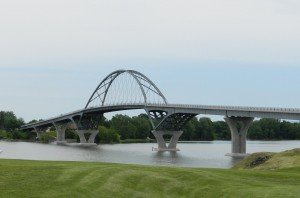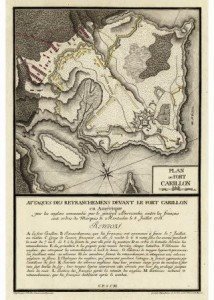
“The Care of the Fortresses of Tyonderoga and Mount Independence being committed to you as commanding Officer…” begins a letter written by General Philip Schyler as he turns over command of Ticonderoga to Colonel Anthony Wayne in the fall of 1776 was recently acquired by Fort Ticonderoga through generous donor support.
This letter provides unique documentation of the minute details Ticonderoga’s officer’s had to be concerned with in order to protect the post from attack and properly care for its troops. “Letters like these are amazing resources that enable historians to better understand how people lived at Ticonderoga during the American Revolution,” said Christopher D. Fox, Fort Ticonderoga’s Curator of Collections. “The information contained within this letter will help museum staff develop accurate and engaging programs for the public.”
Written November 23, 1776, this important letter relays orders to Wayne regarding the security and maintenance of Ticonderoga through the winter. Colonel Wayne is given specific instructions to “continually keep scouting parties on the Lake as long as the Season will permit it to be navigated” and to “pay the strictest Attention to your Guards & Centinels and punish severely the least Remissness in Duty” in order to keep the fortresses secure through the winter. In making sure that the forts can be properly defended in case of attack, Schuyler orders that “All Huts & Buildings that may in the least obstruct the Defense of your posts must be levelled.”
Keeping the winter garrison healthy is also a chief concern on which General Schuyler instructs Colonel Wayne. He writes that a considerable quantity of provisions, livestock, and vegetables are being forwarded to supply the men for three months stating that “You will know of what Importance it is that the greatest attention should be paid to the Health of the Men” and that “having their Victuals properly dressed are capital points and greatly tend to the preservation of the Men.” In addition to provisions being forwarded for the troops, Colonel Wayne is also notified that to help keep the men healthy through the winter “Bedding… will be sent as soon as possible together with a Number of Iron Stoves… to be put up in your Barracks for the greater Conveniencey of the Men” and instructs that barracks chimneys be swept every two weeks.
Fort Ticonderoga’s archival collections consist of thousands of manuscripts, diaries, orderly books, maps, and photographs. The manuscript collections include correspondence of both officers and common soldiers who served at Fort Ticonderoga in the 18th century. Found within the collection are the letters, reports, and returns of Ethan Allen, George Washington, Benedict Arnold, James Abercromby, the Marquis de Montcalm, Robert Rogers, John Burgoyne, Philip Skene, and Jonathan Potts, surgeon to the Northern Department of the Continental Army. Thirty journals and orderly books contain first-hand accounts and day-to-day orders of an army at Fort Ticonderoga and the Lake George / Champlain Valleys during the Seven Years’ War and War for American Independence.
The Fort Ticonderoga Association is a not-for-profit historic site and museum whose mission is to ensure that present and future generations learn from the struggles, sacrifices, and victories that shaped the nations of North America and changed world history. Serving the public since 1909, Fort Ticonderoga engages more than 70,000 visitors annually and is dedicated to the preservation and interpretation of Fort Ticonderoga’s history. The historic site and museum includes the restored fort, museum galleries, Thompson PellResearch Center, and approximately two-thousand acres of land including the King’s Garden, Carillon Battlefield, Mount Defiance, Mount Hope and the northern end of Mount Independence. Fort Ticonderoga is home to one of America’s largest collections of 18th-century military material culture and its research library contains nearly 14,000 published works focusing on the military history of northeastern North America and New France during the 18th century. Philanthropic support by individuals, corporations, and foundations benefits the educational mission of Fort Ticonderoga.Photo: General Philip Schyler letter to Colonel Anthony Wayne, 1776, acquired by Fort Ticonderoga.
 The Memorial Day weekend brings the start of the 2013 season at the Chimney Point, Mount Independence, and Hubbardton Battlefield State Historic Sites. The sites open this Saturday, May 25, at 9:30 a.m.
The Memorial Day weekend brings the start of the 2013 season at the Chimney Point, Mount Independence, and Hubbardton Battlefield State Historic Sites. The sites open this Saturday, May 25, at 9:30 a.m.


 Zarzynski is co-founder of Bateaux Below, co-author (with Bob Benway) of the book Lake George Shipwrecks and Sunken History, and co-authored the documentary Search for the Jefferson Davis: Trader, Slaver, Raider. The documentary, written with Dr. Samuel Turner, was a 2012 Peabody Awards nominee, and an “Official Selection” in the Orlando Film Festival (2011), Amelia Island Film Festival (2012), and the Buffalo Niagara Film Festival (2012). The documentary was named one of three finalists for “Best Documentary” in the 6th Buffalo Niagara Film Festival.
Zarzynski is co-founder of Bateaux Below, co-author (with Bob Benway) of the book Lake George Shipwrecks and Sunken History, and co-authored the documentary Search for the Jefferson Davis: Trader, Slaver, Raider. The documentary, written with Dr. Samuel Turner, was a 2012 Peabody Awards nominee, and an “Official Selection” in the Orlando Film Festival (2011), Amelia Island Film Festival (2012), and the Buffalo Niagara Film Festival (2012). The documentary was named one of three finalists for “Best Documentary” in the 6th Buffalo Niagara Film Festival.
